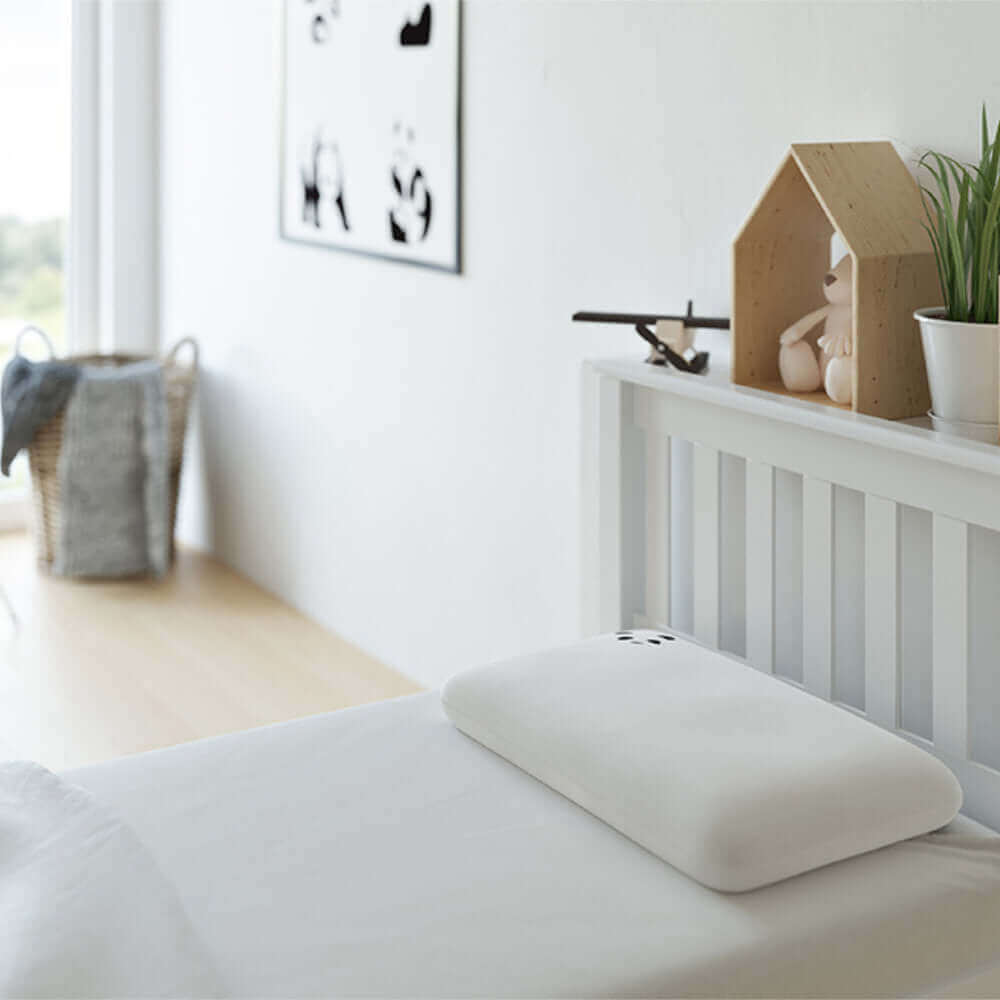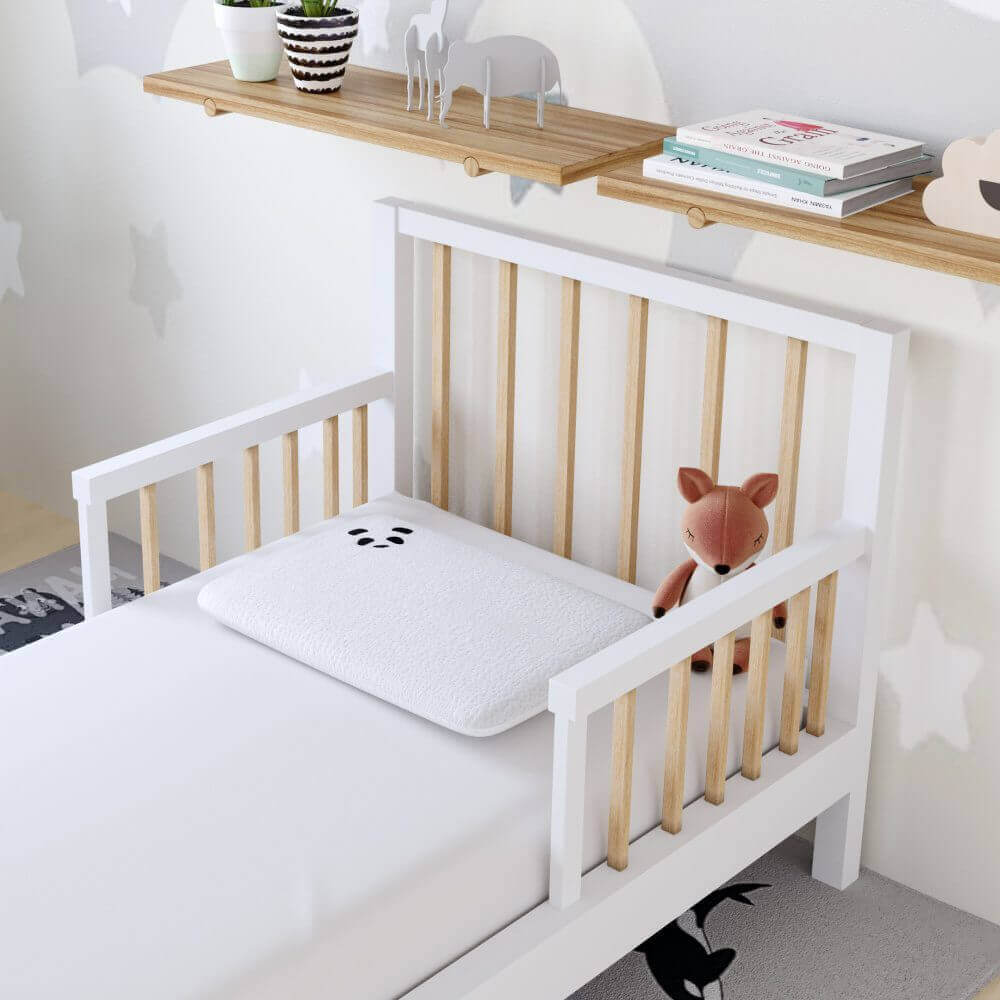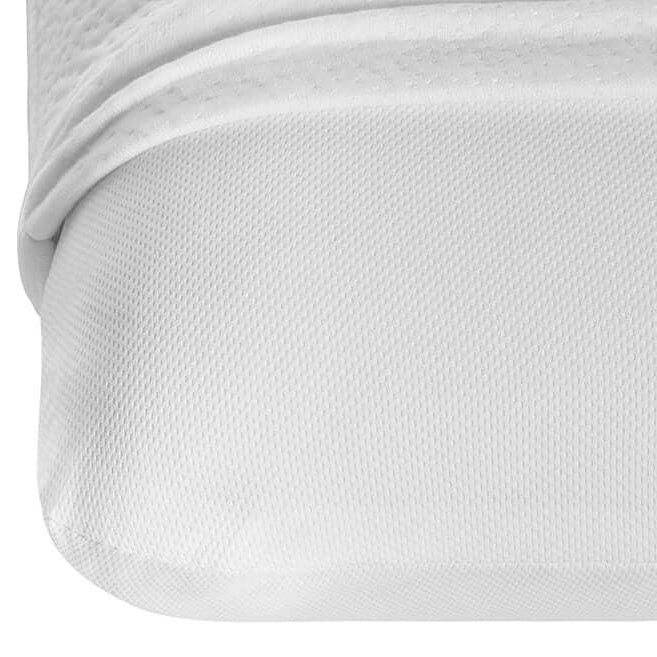It depends on your sleeping position.
- Stomach sleepers – often better without a pillow or with a very thin one, to reduce neck strain.
- Side sleepers – usually need a firm, higher pillow to fill the ear-to-shoulder gap and protect the spine.
- Back sleepers – benefit from a thinner, contouring pillow to avoid neck overextension.
For some, they cannot go anywhere without it; others can have up to three, and then there are a few who can forgo it completely. We’re talking about pillows, of course. But what is the best option for your well-being? To pillow or not to pillow? That is the question.
Pillows prop you up; in essence, they function to support your head and neck to provide neutral spinal alignment. Whether you plump for a pillow is dependent on a few factors. You need to consider the following:
- Your sleeping position
- Body shape
- Any symptoms you experience when you're asleep, such as snoring or neck pain
It’s not necessarily important to have a pillow, but when lying in bed, your head should be level with your torso to benefit your spine and posture. For those of you who suffer from neck ache, a pillow will help to alleviate the pain: the NHS advise a low and firm pillow.
Our sleep panel expert, Dr Seeta, believes that your sleeping position is an important factor in considering the need for a pillow in bed, “This all depends on the positioning of your neck when you sleep. For people who sleep on their stomachs, not using a pillow may help keep the spine in a more natural alignment. However, for back or side sleepers, going without a pillow can strain the neck and shoulders, leading to discomfort over time. As with anything, my advice would be to listen to your body and see what works best for you.”

Is sleeping without a pillow good for stomach sleepers?
Front or stomach sleepers don’t need height when sleeping, so they should aim to sleep without a pillow – or opt for a super thin, ultra-low pillow. To make this position more comfortable, it’s advisable to place a pillow under the pelvis or lower belly to flatten the lower back curve and ease strain on the lumbar region. In the long term, it’s best for stomach sleepers to try to transition away from this position due to the strain it can place on the back.
Do side sleepers need a pillow?
This is the go-to sleeping position for most of us, and side sleepers do need a pillow. Apart from comfort, its main purpose is to bridge the gap between the ear and the mattress when lying on your side. Finding out your loft height (ear to shoulder tip distance) is a reliable measurement on the pillow you need:
- Those with broad shoulders should look for a firm pillow with a higher loft (about 10-13cm / 4-5in)
- A smaller frame should look for a medium loft (about 7-10cm / 3-4in)
Another way to find out the size of the gap is to take a selfie of your body in the sleeping position to determine your loft height. The general mattress rule is that if you have a soft mattress, you’ll need a low pillow, and a firm mattress needs a high pillow. If you don’t have a pillow and you prefer to sleep on your side, you could be heading for trouble, as this causes your neck to bend and shoulder loading. The consequences are neck pain and back aches.
What about back sleepers – thin pillow or none?
Back sleepers should not just rely on their mattress for support, and rather than no pillow at all, a thinner one is recommended. Even though it’s thin, the sleep solution should not be an entirely flat pillow because your head is likely to tip backwards. Contouring memory foam options can adjust to fit around your sleeping position to provide the optimum support. Look for low and medium-profile pillows to avoid neck overextension.
Can sleeping without a pillow help neck pain?
The answer to this question depends on how you sleep. For front sleepers, going without a pillow will help with neck pain, but if you’re a side sleeper, not having a pillow can make it worse. Sleeping on your side requires a pillow tall and firm enough to fill the ear-to-shoulder gap created in this position. The morning after sleeping with a pillow can provide an indication of its effectiveness. Dr Seeta agrees, advising that for some, going without a pillow can provide relief: “It can help in some cases, particularly if you sleep on your stomach, as a pillow can cause your neck to bend unnaturally. Without a pillow, your head stays closer to the mattress, which may reduce strain and ease any tension. However, if you sleep on your back or side, not using a pillow might actually make neck pain worse due to lack of support for your head and neck. “
Does a no-pillow bedtime help with snoring or breathing?
If you snore, have sleep apnea or acid reflux, the zero pillow approach is not a good idea. If you suffer from these conditions, you need elevation during the night, and therefore you shouldn’t go without a pillow. Dr Seeta suggests that a pillow sometimes helps prevent snoring, “For some people, sleeping without a pillow may improve breathing slightly by keeping the airways more open. However, most people benefit from a pillow that supports the head and keeps the neck aligned, which can also reduce snoring.”
When you’re on your back, lying flat means the tongue and soft palate fall backwards, narrowing the airway. A thin pillow or slight elevation keeps the airway more open. However, on your side, you generally need a pillow to keep your neck neutral; without one your head droops, which can also narrow the airway.
There is a group who are an exception to the pillow rule. Stomach sleepers who snore can go without a pillow, or they should use an ultra-thin pillow.
Who should never use a pillow?
Babies up to 12 months don’t need a pillow and for safety reasons they shouldn’t have one. At this age, they’re more likely to be at risk of suffocation at night. As mentioned, those who sleep on their front will benefit by going without a pillow. Dr Seeta explains that having no pillow is best for these groups, “Those who consistently sleep on their stomachs might be better off without a pillow, as it prevents excessive neck twisting. People with neck, shoulder, or back problems should not give up their pillow without consulting a doctor or physiotherapist first. Infants should also never use pillows due to the risk of suffocation.”
If you’re suffering a neck injury, acid reflux or you’re pregnant, you should consult a clinician on your best bed set-up – but a pillow is highly recommended. We’ve provided advice on how to get the most out of a cushioned companion.
Acute neck injury: If you’re a back sleeper, opt for a thin pillow. Side sleepers should have a medium to firm pillow that exactly matches their shoulder width.
Reflux: a pillow plus a wedge so the torso is elevated on the left side if possible.
Pregnancy (trimester 2–3): a side-sleeper should have a head pillow and a body/knee/bump wedge; add a torso wedge if you’re suffering from reflux.

How to test “no pillow” safely
If you’re unsure of the pillow you need, or you think you can go without, conduct a three-night experiment. This uses materials which mimic a pillow and assess how you feel the next morning. Below is how to conduct the test depending on your position:
- Back sleepers – place a rolled towel in the pillow case under the neck, and adjust its thickness until your neck feels better the next day.
-
Side sleepers – trial a rolled-up T-shirt and compare it with 1-2cm of foam, then see which improves symptoms of neck pain as an indication of pillow support.
-
Front sleepers - try a body pillow at mid-section to reduce twist, as this helps to train you into a side sleeping position.
Keep a journal beside your bed so you can track your symptoms; if your neck or shoulder pain gets worse with this method, you should not continue.
How to choose the right pillow (if “no pillow” isn’t for you)
Let’s face it, with all the options on the market, poor pillows shouldn’t come between you and a good night’s sleep. If you’re used to having a pillow to rest your head on and you don’t like to go without, you need to consider which one is most aligned with your comfort and needs. When you’re asleep, the aim is to have your head level with your spine. If you’re on your side, this pillow should have an adjustable or higher loft height to fill the gap between the mattress and your shoulder. If you like to sleep on your back, choose a pillow which is low and has contouring to avoid extension. Stomach sleepers should try to find a pillow setup that transitions from lying on their front to a side sleeping position.
Designed to take the weight off your shoulders, our Memory Foam Bamboo Pillow features orthopaedically-approved memory foam which contours to your sleeping position. Keeping your head and neck in perfect alignment, it’s wrapped up in a super soft breathable bamboo cover.
If you’re suffering from neck or shoulder pain, our Hybrid Bamboo Pillow contains our innovation of CharcoCell Foam™ – a unique bamboo charcoal infusion with pressure-sensitive, third-generation memory foam that helps to provide personalised targeted support and alleviates aches.
Conclusion
Pillows can be a successful sleeping aid in achieving a better night’s sleep, but only if they provide neutral alignment. To recap, side and back sleepers need a highly supportive and contouring pillow to fill in gaps and prevent hyperextension. Stomach sleepers are best suited to having a slim pillow or even none at all. If you sleep on your front, a pillow should be placed under the torso to reduce the curve in the back; the aim being to transition from the front to a side sleeping position.
If you’re experiencing tension or strain in your neck or shoulders, conduct a trial period of three to five nights with a slim pillow to see if symptoms improve. If you’re considering a pillow for your baby, they must be older than 12 months before they sleep with one. If you have an injury or are pregnant, consult a clinician for the best advice on using a pillow and its benefits. A memory foam bamboo pillow is a highly adaptable option, suiting all sleeping positions and providing spinal alignment. Highly breathable, a bamboo pillow is also thermoregulating, hypoallergenic and moisture-wicking, so be prepared to reach new heights of restorative sleep with one of our pillows.
FAQ
1. Why do some people prefer sleeping without a pillow?
Some find pillows uncomfortable or blame them for neck pain. Others like the natural flat alignment or a simpler bedding setup.
2. How can I sleep comfortably without a pillow?
Start gradually with a thinner pillow or rolled towel. Ensure your mattress is supportive and try back-sleeping first to avoid strain.
3. Will I sleep better without a pillow?
It depends. Stomach sleepers may rest better without one, but side and back sleepers usually need support. Comfort and alignment are key.
4. Can sleeping without a pillow help with snoring?
For some, lying flat can reduce snoring. But for back sleepers, it may worsen it, as the tongue can block the airway. Position matters most.
5. Can going pillow-free help with allergies?
Possibly. Pillows trap dust and mites, so skipping one may reduce allergens. But clean bedding and mattress hygiene matter more.
6. How many pillows should I use?
One supportive pillow is usually best. Too many can misalign the spine. Use extra pillows only for comfort under the knees or between the legs.
7. Should babies or young children sleep without pillows?
Yes. Babies under 12 months should never use a pillow for safety. Toddlers can go pillow-free until they need a small, firm kids’ pillow.
Fact-checked by: Dr Seeta Shah

![[MattressTopper] Panda London Memory Foam Bamboo Mattress Topper package box](http://pandalondon.com/cdn/shop/files/Bamboo_Mattress_Topper_Package_Box.webp?v=1742301823&width=1500)
![[MattressTopper] Panda London Memory Foam Bamboo Mattress Topper on the floor](http://pandalondon.com/cdn/shop/products/Panda-Memory-Foam-Bamboo-Mattress-Topper-Yoga-e1624045454555.jpg?v=1758795458&width=1000)
![[MattressTopper] Bamboo Mattress Topper Lifestyle Image with Memory Foam Pillows Product Page](http://pandalondon.com/cdn/shop/files/Bamboo_Mattress_Topper_Lifestyle_Image_with_Memory_Foam_Pillows_Product_Page.webp?v=1758795458&width=800)
![[MattressTopper] Bamboo Mattress Topper Lifestyle Image with Bamboo Pillows In the Garden room Product Page](http://pandalondon.com/cdn/shop/files/Bamboo_Mattress_Topper_Lifestyle_Image_with_Bamboo_Pillows_In_the_Garden_room_Product_Page.webp?v=1758795458&width=800)
![[MattressTopper] Panda London Memory Foam Bamboo Mattress Topper side](http://pandalondon.com/cdn/shop/files/Mattress_Topper_Isolated_-_resized.jpg?v=1758795458&width=800)
![[HybridMattressPro] Hybrid_Bamboo_Mattress_Pro_Product_Image_2026](http://pandalondon.com/cdn/shop/files/Hybrid_Bamboo_Mattress_Pro_Product_Image_2026.webp?v=1764944771&width=1000)
![[HybridMattressPro] Breathable Hybrid Bamboo Mattress](http://pandalondon.com/cdn/shop/products/Breathable-Hybrid-Bamboo-Mattress.jpg?v=1764944771&width=1920)
![[HybridMattressPro] Hybrid Bamboo Mattress Pro Cover Zip](http://pandalondon.com/cdn/shop/files/Hybrid_Bamboo_Mattress_Cover.jpg?v=1764944771&width=800)
![[HybridMattressPro] Panda Hybrid Bamboo Mattress Pro](http://pandalondon.com/cdn/shop/files/Hybrid_Bambo_Memory_Foam_Mattress_-_BioCell_Foam_x.jpg?v=1764944771&width=800)
![[HybridMattressPro] Couple on a Hybrid Bamboo Mattress Pro](http://pandalondon.com/cdn/shop/files/Hybrid_Bamboo_Mattress_Couple.jpg?v=1764944771&width=800)
![[CloudDuvet] Panda London The Cloud Bamboo Duvet Packaging](http://pandalondon.com/cdn/shop/products/Panda-London-The-Cloud-Bamboo-Duvet-Panda-Life-scaled_00a651ad-4ca3-4105-b520-12a94c1a4f71.jpg?v=1713363286&width=1920)
![[CloudDuvet] Panda London The Cloud Bamboo Duvet Rolled](http://pandalondon.com/cdn/shop/products/Duvet-Listing-Images03.jpg?v=1764079307&width=1000)
![[CloudDuvet] Panda London The Cloud Bamboo Duvet Girl Huggin a Duvet on the Bed](http://pandalondon.com/cdn/shop/files/Cloud_Bamboo_Duvet_-_Lady_Hugging_it_on_Bed_LifestyleImage.jpg?v=1764079307&width=1000)
![[CloudDuvet] Panda London The Cloud Bamboo Duvet Guy In the Air with Cloud Bamboo Duvet](http://pandalondon.com/cdn/shop/files/GuyonaHybridBambooMattresswithCloudDuvet.jpg?v=1764079307&width=2000)
![[CloudDuvet] Panda Cloud Duvet Winter on the bed lifestyle image](http://pandalondon.com/cdn/shop/files/Panda_Cloud_Duvet_Winter_on_the_Bed_Lifestyle-1_image.jpg?v=1764079307&width=1000)
![[BBWhite] White 100% Bamboo Bedding](http://pandalondon.com/cdn/shop/files/Pure_White_Full_Bed.webp?v=1719581797&width=1000)
![[BBWhite] White 100% Bamboo Bedding Texture](http://pandalondon.com/cdn/shop/files/100_Bamboo_Bedding_-_Pure_White_-_Close_Up_02.webp?v=1762879591&width=1000)
![[BBWhite] White 100% Bamboo Bedding Woman in bed sleeping](http://pandalondon.com/cdn/shop/files/100-Bamboo-Bedding-Set-Pure-White-BB.webp?v=1762879591&width=768)
![[BBWhite] White 100% Bamboo Bedding Woman Duvet cover buttons](http://pandalondon.com/cdn/shop/files/hand_and_buttons_1.webp?v=1762879591&width=1000)
![[BBWhite] White 100% Bamboo Bedding Woman in bed looking and smiling-](http://pandalondon.com/cdn/shop/files/SatonMadeBed-White100_BambooBedding-white_-_BB_SideShot1000x1000.webp?v=1762879591&width=980)
![[BBUrbanGrey] Urban Grey 100% Bamboo Bedding](http://pandalondon.com/cdn/shop/files/Made_Bed_-_Urban_Grey_-_Wide_Shot_2_1_1.webp?v=1762880019&width=1000)
![[BBUrbanGrey] Cloud Duvet Urban Grey 100% Bamboo Bedding Set](http://pandalondon.com/cdn/shop/files/Cloud_Duvet_-_Grey_-_Close_up_2.webp?v=1762880019&width=1000)
![[BBUrbanGrey] Urban Grey 100% Bamboo Bedding Set Woman sitting on the bed](http://pandalondon.com/cdn/shop/files/Sat_in_Bed_-_Grey_100__Bamboo_Bedding_-_Wide_Shot.webp?v=1762880019&width=1000)
![[BBUrbanGrey] Urban Grey 100% Bamboo Bedding Set Woman Duvet buttons Panda London](http://pandalondon.com/cdn/shop/files/hand_buttons_grey_bedding_1.webp?v=1762880019&width=1000)
![[BBUrbanGrey] Woman Sitting on the Bamboo Bedding with coffee](http://pandalondon.com/cdn/shop/files/SatonMadeBed-White100_BambooBedding-SideShot1000x1000.jpg?v=1762880019&width=1000)
![[BBNavyBlue] Deep Sea Navy Blue 100% Bamboo Bedding](http://pandalondon.com/cdn/shop/files/Made_Bed_-_Navy_-_Wide_Shot_3_copy.webp?v=1762879591&width=1000)
![[BBNavyBlue] Deep Sea Navy Blue 100% Bamboo Bedding Texture](http://pandalondon.com/cdn/shop/files/Cloud_Duvet_-_Navy_-_Close_up_2.webp?v=1762880019&width=1000)
![[BBNavyBlue] Deep Sea Navy Blue 100% Bamboo Bedding Woman Sitting on the bed](http://pandalondon.com/cdn/shop/files/Sat_Up_in_Bed_-_Navy_100__Bamboo_Bedding_-_Hands_on_Bed.webp?v=1762880019&width=1000)
![[BBNavyBlue] Deep Sea Navy Blue 100% Bamboo Bedding Duvet Cover Buttons](http://pandalondon.com/cdn/shop/files/Cloud_Duvet_Cover_Buttons_-_Deep_Sea_Navy.webp?v=1762880019&width=1000)
![[BBNavyBlue] Deep Sea Navy Blue 100% Bamboo Bedding Woman sitting on the bed looking away](http://pandalondon.com/cdn/shop/files/SatonMadeBed-White100_BambooBedding-SideShot1000x1000-001.webp?v=1762880019&width=980)
![[BBPink] Vintage Pink Blue 100% Bamboo Bedding](http://pandalondon.com/cdn/shop/files/Made_Bed_-_Pink_-_Wide_Shot_copy.webp?v=1762879591&width=1000)
![[BBPink] Vintage Pink Texture 100% Bamboo Bedding](http://pandalondon.com/cdn/shop/files/Cloud_Duvet_-_Pink_-_Close_up_2.webp?v=1762880019&width=1000)
![[BBPink] Vintage Pink Woman Sitting on the 100% Bamboo Bedding](http://pandalondon.com/cdn/shop/files/Sat_Up_in_Bed_-_Pink_-_Hands_on_Bed.webp?v=1762880019&width=1000)
![[BBPink] Vintage Pink Woman Sitting on the 100% Bamboo Bedding Duvet Cover](http://pandalondon.com/cdn/shop/files/Cloud_Duvet_Cover_Buttons_-_Vintage_Pink.webp?v=1762880019&width=1000)
![[BBPink] Vintage Pink Woman Sitting on the 100% Bamboo Bedding Woman looking far away](http://pandalondon.com/cdn/shop/files/SatonMadeBed-White100_BambooBedding-SideShot1000x1000-001_Vintage_Pink.webp?v=1762880019&width=980)
![[BBGrey] Light Grey 100% Bamboo Bedding](http://pandalondon.com/cdn/shop/files/Made_Bedding_in_Bedroom_-_Urban_Grey_-_Wide_Shot.webp?v=1762879591&width=1000)
![[BBGrey] Light Grey 100% Bamboo Bedding texture](http://pandalondon.com/cdn/shop/files/Texture17.webp?v=1762880019&width=1000)
![[BBGrey] Light Grey 100% Bamboo Bedding with Woman smiling](http://pandalondon.com/cdn/shop/files/Sat_Up_in_Bed_-_Grey_-_Hands_on_Bed.webp?v=1762880019&width=1000)
![[BBGrey] Light Grey 100% Bamboo Bedding with Duvet Cover buttons](http://pandalondon.com/cdn/shop/files/Cloud_Duvet_Cover_Buttons_-_Quiet_Grey.webp?v=1762880019&width=1000)
![[BBGrey] Light Grey 100% Bamboo Bedding with Woman smiling and sitting coffee](http://pandalondon.com/cdn/shop/files/SatonMadeBed-White100_BambooBedding-SideShot1000x1000-002-_Grey.webp?v=1762880019&width=980)
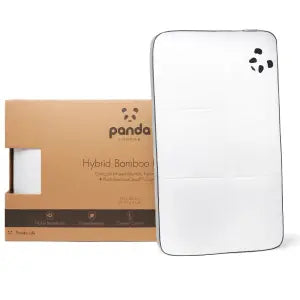 Hybrid Bamboo Pillow
Hybrid Bamboo Pillow Memory Foam Bamboo Pillow
Memory Foam Bamboo Pillow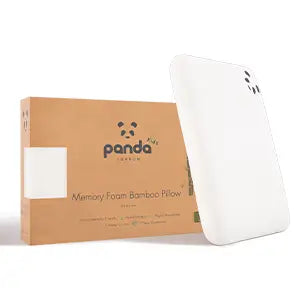 Kids Memory Foam Bamboo Pillow
Kids Memory Foam Bamboo Pillow Baby Memory Foam Bamboo Pillow
Baby Memory Foam Bamboo Pillow Panda Cloud Duvet
Panda Cloud Duvet Bamboo Summer Duvet
Bamboo Summer Duvet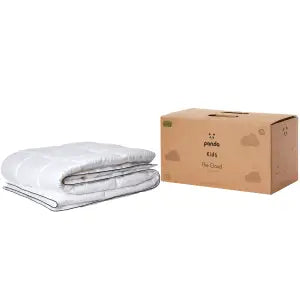 Kids Cloud Duvet
Kids Cloud Duvet
![[BBPureWhitePillowcases] Bamboo Bedding Two Pure White Pillowcases](http://pandalondon.com/cdn/shop/files/Pure_White_Pillowcase_Bamboo_Bedding_Two_Pillows.webp?v=1721308652&width=1000)
![[BBPureWhitePillowcases] Bamboo Bedding Two Pure White Pillowcases Package](http://pandalondon.com/cdn/shop/files/Pure_White_Bamboo_Bedding_Pillowcases.webp?v=1721308652&width=1820)
![[BBPureWhitePillowcases] Bamboo Bedding Two Pure White Pillowcases Texture](http://pandalondon.com/cdn/shop/files/Pure_White_Pillowcase_Bamboo_Bedding_Texture.webp?v=1721308653&width=980)
![[BBPureWhitePillowcases] Bamboo Bedding Two Pure White Pillowcases Couples Changing Pillows](http://pandalondon.com/cdn/shop/files/Pure_White_Pillowcase_Bamboo_Bedding_Pillowcases_Changing.webp?v=1721308653&width=1000)
![[BBPureWhitePillowcases] Bamboo Bedding Two Pure White Pillowcases - Pillows on the bed](http://pandalondon.com/cdn/shop/files/Pure_White_Bamboo_Bedding_Pillowcases_Bamboo_Bedding_On_the_Bed.webp?v=1721308651&width=724)
![[BBNavyPillowcases] Bamboo Bedding Two Navy Pillowcases](http://pandalondon.com/cdn/shop/files/DeepSeaNavyPillowcaseBambooBeddingTwoPillows.webp?v=1721307802&width=1000)
![[BBNavyPillowcases] Bamboo Bedding Two Navy Pillowcases Package](http://pandalondon.com/cdn/shop/files/DeepSeaNavyPillowcaseBambooBedding.webp?v=1721307801&width=1820)
![[BBNavyPillowcases] Bamboo Bedding Two Navy Pillowcases Texture](http://pandalondon.com/cdn/shop/files/DeepSeaNavyPillowcaseBambooBeddingTexture.webp?v=1721307802&width=1000)
![[BBNavyPillowcases] Bamboo Bedding Two Navy Pillowcases Couple Changing](http://pandalondon.com/cdn/shop/files/DeepSeaNavyPillowcaseBambooBeddingPillowcasesChanging.webp?v=1721307802&width=1000)
![[BBNavyPillowcases] Bamboo Bedding Two Navy Pillowcases on the Bamboo Bedding](http://pandalondon.com/cdn/shop/files/Deep_Sea_Navy_Pillowcase_On_the_Bed.webp?v=1721308056&width=724)
![[BBQuietGreyPillowcases] Bamboo Bedding Two Quiet Grey Pillowcases](http://pandalondon.com/cdn/shop/files/Quiet_Grey_Bamboo_Bedding_Pillowcases_Two_Pillows.webp?v=1721308123&width=1000)
![[BBQuietGreyPillowcases] pacakge Pillowcases Bamboo bedding](http://pandalondon.com/cdn/shop/files/Quiet_Grey_Bamboo_Bedding_Pillowcases.webp?v=1721308123&width=1820)
![[BBQuietGreyPillowcases] Texture Pillowcases](http://pandalondon.com/cdn/shop/files/Quiet_Grey_Bamboo_Bedding_Pillowcases_Texture.jpg?v=1721308123&width=980)
![[BBQuietGreyPillowcases] Couple Changing Pillowcases](http://pandalondon.com/cdn/shop/files/Quiet_Grey_Bamboo_Bedding_Pillowcases_Changing.webp?v=1721308124&width=1000)
![[BBQuietGreyPillowcases] Pillows on the Bamboo Bed Panda London](http://pandalondon.com/cdn/shop/files/Quiet_Grey_Bamboo_Bedding_Pillowcases_On_the_Bed.webp?v=1721308123&width=724)
![[BBUrbanGreyPillowcases] Bamboo Bedding Two urban Grey Pillowcases](http://pandalondon.com/cdn/shop/files/Urban_Grey_Bamboo_Bedding_Pillowcases_Two_Pillows.webp?v=1721308480&width=1000)
![[BBUrbanGreyPillowcases] Bamboo Bedding Two urban Grey Package](http://pandalondon.com/cdn/shop/files/Urban_Grey_Bamboo_Bedding_Pillowcases.webp?v=1721308480&width=1820)
![[BBUrbanGreyPillowcases] Bamboo Bedding Two urban Grey Pillowcases Texture](http://pandalondon.com/cdn/shop/files/Urban_Grey_Bamboo_Bedding_Pillowcases_Texture.webp?v=1721308481&width=1000)
![[BBUrbanGreyPillowcases] Bamboo Bedding Two urban Grey Pillowcases Changing](http://pandalondon.com/cdn/shop/files/Urban_Grey_Bamboo_Bedding_Pillowcases_Chaning.webp?v=1721308481&width=1000)
![[BBUrbanGreyPillowcases] Bamboo Bedding Two urban Grey Pillowcases on the bed](http://pandalondon.com/cdn/shop/files/Urban_Grey_Bamboo_Bedding_Pillowcases_On_the_Bed.webp?v=1721308479&width=724)
![[BBVintagePinkPillowcases] Bamboo Bedding Two Vintage Pink Pillowcases](http://pandalondon.com/cdn/shop/files/Vintage_Pink_Bamboo_Bedding_Pillowcases_Two_Pillows.webp?v=1721308783&width=1000)
![[BBVintagePinkPillowcases] Bamboo Bedding Two Vintage Pink Package](http://pandalondon.com/cdn/shop/files/Vintage_Pink_Bamboo_Bedding_Pillowcases.webp?v=1721308783&width=1820)
![[BBVintagePinkPillowcases] Bamboo Bedding Two Vintage Pink Pillowcases Texture](http://pandalondon.com/cdn/shop/files/Vintage_Pink_Bamboo_Bedding_Pillowcases_Texture.webp?v=1721308784&width=1000)
![[BBVintagePinkPillowcases] Bamboo Bedding Two Vintage Pink Pillowcases](http://pandalondon.com/cdn/shop/files/Vintage_Pink_Bamboo_Bedding_Pillowcases_Chaning_Pillows.webp?v=1721308784&width=1000)
![[BBVintagePinkPillowcases] Bamboo Bedding Two Vintage Pink Pillows on the Bamboo Bedding](http://pandalondon.com/cdn/shop/files/Vintage_Pink_Bamboo_Bedding_Pillowcases_On_the_Bed.webp?v=1721308782&width=724)
![[HybridPillow] Hybrid Bamboo Pillow - Mattress Campaign](http://pandalondon.com/cdn/shop/products/Hybrid-Bamboo-Pillow-Mattress-Campaign.jpg?crop=region&crop_height=1615&crop_left=152&crop_top=0&crop_width=1615&v=1750023555&width=1920)
![[HybridPillow] Hybrid Pillow with Panda brand marking](http://pandalondon.com/cdn/shop/products/Hybrid-Pillow_8.jpg?v=1750023555&width=1920)
![[HybridPillow] Couples laying on Hybrid Bamboo Pillows](http://pandalondon.com/cdn/shop/files/Hybrid_Bamboo_Pillow_Product.jpg?v=1750023555&width=1000)
![[HybridPillow] Red Hair Girl sleeping on a Hybrid Bamboo Pillow](http://pandalondon.com/cdn/shop/files/Hybrid_Bamboo_Pillow_-_Red_Hair_Girl_Product.jpg?v=1750023555&width=1000)
![[HybridPillow] Guy Hugging Hybrid Bamboo Pillow](http://pandalondon.com/cdn/shop/files/Hybrid-Bamboo-Pillow-Man-holding-the-pillow-1024x1024_jpg.webp?v=1750023555&width=1024)
![[MemoryFoamPillow] Panda Luxury Memory Foam Bamboo product image](http://pandalondon.com/cdn/shop/products/Panda-Memory-Foam-Bamboo-Pillow-Panda-Life-scaled-e1623788835840.jpg?v=1750023574&width=800)
![[MemoryFoamPillow] Panda London Bamboo Memory Foam Pillow](http://pandalondon.com/cdn/shop/files/03_Memory_Foam_Bamboo_Pillow__alt01.jpg?v=1750023574&width=800)
![[MemoryFoamPillow] Panda London Bamboo Memory Foam Pillow girl hugging the pillow](http://pandalondon.com/cdn/shop/files/02_Memory_Foam_Bamboo_Pillow__alt02.jpg?v=1750023574&width=800)
![[MemoryFoamPillow] Panda London Bamboo Memory Foam Pillow on a Panda Topper](http://pandalondon.com/cdn/shop/files/Memory-Foam-Bamboo-Pillow-on-Bed-Topper-and-Adjustable-Straps-Shown-Lifestyle-Square-768x768_png.webp?v=1763983719&width=768)
![[MemoryFoamPillow] Panda London Bamboo Memory Foam Pillow Girl Holding Pillow Lifestyle](http://pandalondon.com/cdn/shop/files/01_Memory_Foam_Bamboo_Pillow__alt04.jpg?v=1763983719&width=800)

![[Pillowcovers] Pillowcase-Kids-Pillow-White-Background-](http://pandalondon.com/cdn/shop/files/Kids-Pillow-White-Background-Square_jpg.webp?v=1713361847&width=745)
